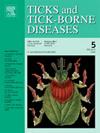Estimating the density of questing Ixodes scapularis nymphs in the eastern United States using climate and land cover data
IF 3.4
2区 医学
Q2 INFECTIOUS DISEASES
引用次数: 0
Abstract
Tick-borne diseases pose a persistent and increasing threat to public health. In the United States, the majority of human infections are caused by pathogens spread by the blacklegged tick, Ixodes scapularis. Most infections are reported during the summer months, when nymphal ticks are active in states in the Northeast and Upper Midwest. The density of questing I. scapularis nymphs (DON) provides an estimate for the risk of human encounters with nymphs, but it is a resource intensive metric to obtain from field sampling. Thus, DON estimates are limited in the US national tick surveillance database, the ArboNET Tick Module. We estimated DON across all counties in the eastern US using a zero-inflated negative binomial model utilizing tick surveillance data reported to ArboNET (2004–2023) as well as climate and land cover data. The model estimated generally low DON across the southeastern US and Great Plains states with higher estimates in the Upper Midwest and Northeast regions. We assigned counties to relative acarological encounter risk categories based on estimated DON: zero or lower quartile DON estimates were scored as low risk, whereas inter- and upper-quartile DON estimates were scored as moderate-high risk. Counties with moderate-high DON reported from field sampling were accurately categorized by the model as moderate-high encounter risk (99 % sensitivity). However, 80 % of sampled counties reporting low DON were classified as moderate-high risk (20 % specificity). These misclassified counties were typically situated in recently colonized areas in the Northeast and Upper Midwest and likely indicated areas potentially suitable for tick population expansion. Our model yielded a very high negative predictive value (96 %) indicating the model did very well estimating low relative encounter risk in counties where no or few nymphs were collected, and a fair positive predictive value (60 %) indicated that densities may not have reached an expected peak in some locations, particularly in the Northeast, Upper Midwest, and northern states in the Southeast. Further tick surveillance is needed to evaluate and to refine these predictions. The resulting maps are useful for estimating relative risk of nymphal encounters across the eastern US where field data are sparse and may aid in efforts aimed at promoting the use of personal protective measures in communities that are at risk for nymphal tick encounters.
利用气候和土地覆盖数据估算美国东部的肩胛骨冰蚊若虫密度。
蜱传疾病对公共卫生构成持续和日益严重的威胁。在美国,大多数人类感染是由黑腿蜱(肩胛骨蜱)传播的病原体引起的。据报道,大多数感染发生在夏季,当蜱虫在东北部和中西部北部活跃时。采集的肩胛棘夜蛾若虫(DON)密度为人类接触若虫的风险提供了一个估计,但这是一个需要从野外采样中获得的资源密集型指标。因此,DON估计在美国国家蜱虫监测数据库ArboNET蜱虫模块中是有限的。我们利用向ArboNET报告的蜱虫监测数据(2004-2023)以及气候和土地覆盖数据,使用零膨胀负二项模型估计了美国东部所有县的DON。该模式估计美国东南部和大平原各州的DON总体较低,而中西部上游和东北部地区的DON估计较高。我们根据估计的DON将县划分为相对的考古学遭遇风险类别:零或更低的四分位数DON估计值被评为低风险,而四分位数间和上四分位数DON估计值被评为中高风险。从实地抽样中报告的中高DON的县被模型准确地归类为中高遭遇风险(99%的灵敏度)。然而,80%报告低DON的抽样县被归类为中-高风险(20%特异性)。这些被错误分类的县通常位于东北部和中西部上游最近被殖民的地区,可能表明这些地区可能适合蜱虫种群扩张。我们的模型产生了非常高的负预测值(96%),表明该模型非常好地估计了没有或很少收集到若虫的县的低相对遭遇风险,并且一个相当积极的预测值(60%)表明密度可能没有达到某些地方的预期峰值,特别是在东北部,中西部北部和东南部的北部州。需要进一步监测蜱虫,以评估和完善这些预测。由此产生的地图有助于估计美国东部地区蜱虫接触的相对风险,那里的实地数据很少,并可能有助于促进在有蜱虫接触风险的社区使用个人保护措施。
本文章由计算机程序翻译,如有差异,请以英文原文为准。
求助全文
约1分钟内获得全文
求助全文
来源期刊

Ticks and Tick-borne Diseases
INFECTIOUS DISEASES-MICROBIOLOGY
CiteScore
6.90
自引率
12.50%
发文量
185
审稿时长
6-12 weeks
期刊介绍:
Ticks and Tick-borne Diseases is an international, peer-reviewed scientific journal. It publishes original research papers, short communications, state-of-the-art mini-reviews, letters to the editor, clinical-case studies, announcements of pertinent international meetings, and editorials.
The journal covers a broad spectrum and brings together various disciplines, for example, zoology, microbiology, molecular biology, genetics, mathematical modelling, veterinary and human medicine. Multidisciplinary approaches and the use of conventional and novel methods/methodologies (in the field and in the laboratory) are crucial for deeper understanding of the natural processes and human behaviour/activities that result in human or animal diseases and in economic effects of ticks and tick-borne pathogens. Such understanding is essential for management of tick populations and tick-borne diseases in an effective and environmentally acceptable manner.
 求助内容:
求助内容: 应助结果提醒方式:
应助结果提醒方式:


